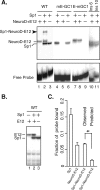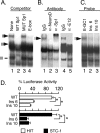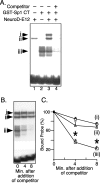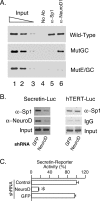The basic helix-loop-helix transcription factor NeuroD1 facilitates interaction of Sp1 with the secretin gene enhancer
- PMID: 17875929
- PMCID: PMC2169158
- DOI: 10.1128/MCB.00438-07
The basic helix-loop-helix transcription factor NeuroD1 facilitates interaction of Sp1 with the secretin gene enhancer
Abstract
The basic helix-loop-helix transcription factor NeuroD1 is required for late events in neuronal differentiation, for maturation of pancreatic beta cells, and for terminal differentiation of enteroendocrine cells expressing the hormone secretin. NeuroD1-null mice demonstrated that this protein is essential for expression of the secretin gene in the murine intestine, and yet it is a relatively weak transcriptional activator by itself. The present study shows that Sp1 and NeuroD1 synergistically activate transcription of the secretin gene. NeuroD1, but not its widely expressed dimerization partner E12, physically interacts with the C-terminal 167 amino acids of Sp1, which include its DNA binding zinc fingers. NeuroD1 stabilizes Sp1 DNA binding to an adjacent Sp1 binding site on the promoter to generate a higher-order DNA-protein complex containing both proteins and facilitates Sp1 occupancy of the secretin promoter in vivo. NeuroD-dependent transcription of the genes encoding the hormones insulin and proopiomelanocortin is potentiated by lineage-specific homeodomain proteins. The stabilization of binding of the widely expressed transcription factor Sp1 to the secretin promoter by NeuroD represents a distinct mechanism from other NeuroD target genes for increasing NeuroD-dependent transcription.
Figures







Similar articles
-
Novel transcriptional potentiation of BETA2/NeuroD on the secretin gene promoter by the DNA-binding protein Finb/RREB-1.Mol Cell Biol. 2003 Jan;23(1):259-71. doi: 10.1128/MCB.23.1.259-271.2003. Mol Cell Biol. 2003. PMID: 12482979 Free PMC article.
-
Regulation of the human secretin gene is controlled by the combined effects of CpG methylation, Sp1/Sp3 ratio, and the E-box element.Mol Endocrinol. 2004 Jul;18(7):1740-55. doi: 10.1210/me.2003-0461. Epub 2004 Apr 29. Mol Endocrinol. 2004. PMID: 15118068
-
CtBP and associated LSD1 are required for transcriptional activation by NeuroD1 in gastrointestinal endocrine cells.Mol Cell Biol. 2014 Jun;34(12):2308-17. doi: 10.1128/MCB.01600-13. Epub 2014 Apr 14. Mol Cell Biol. 2014. PMID: 24732800 Free PMC article.
-
Transcriptional regulation of secretin gene expression.J Clin Gastroenterol. 1995;21 Suppl 1:S50-55. J Clin Gastroenterol. 1995. PMID: 8774991 Review.
-
Review article: transcriptional events controlling the terminal differentiation of intestinal endocrine cells.Aliment Pharmacol Ther. 2000 Apr;14 Suppl 1:170-5. doi: 10.1046/j.1365-2036.2000.014s1170.x. Aliment Pharmacol Ther. 2000. PMID: 10807420 Review.
Cited by
-
Bio-informatics analysis of a gene co-expression module in adipose tissue containing the diet-responsive gene Nnat.BMC Syst Biol. 2010 Dec 27;4:175. doi: 10.1186/1752-0509-4-175. BMC Syst Biol. 2010. PMID: 21187013 Free PMC article.
-
Sp1 and Sp3 regulate transcription of the cyclin-dependent kinase 5 regulatory subunit 2 (p39) promoter in neuronal cells.Biochim Biophys Acta. 2009 Mar;1789(3):204-11. doi: 10.1016/j.bbagrm.2009.01.007. Biochim Biophys Acta. 2009. PMID: 19437621 Free PMC article.
-
Predicting tissue specific cis-regulatory modules in the human genome using pairs of co-occurring motifs.BMC Bioinformatics. 2012 Feb 7;13:25. doi: 10.1186/1471-2105-13-25. BMC Bioinformatics. 2012. PMID: 22313678 Free PMC article.
-
Conditional deletion of Atoh1 using Pax2-Cre results in viable mice without differentiated cochlear hair cells that have lost most of the organ of Corti.Hear Res. 2011 May;275(1-2):66-80. doi: 10.1016/j.heares.2010.12.002. Epub 2010 Dec 10. Hear Res. 2011. PMID: 21146598 Free PMC article.
-
The role of bHLH genes in ear development and evolution: revisiting a 10-year-old hypothesis.Cell Mol Life Sci. 2010 Sep;67(18):3089-99. doi: 10.1007/s00018-010-0403-x. Epub 2010 May 22. Cell Mol Life Sci. 2010. PMID: 20495996 Free PMC article. Review.
References
-
- Cong, Y.-S., J. Wen, and S. Bacchetti. 1999. The human telomerase catalytic subunit hTERT: organization of the gene and characterization of the promoter. Hum. Mol. Genet. 8:137-142. - PubMed
-
- Courey, A. J., and R. Tjian. 1988. Analysis of Sp1 in vivo reveals multiple transactivational domains, including a novel glutamine-rich activation motif. Cell 55:887-898. - PubMed
-
- Dumonteil, E., B. Laser, I. Constant, and J. Philippe. 1998. Differential regulation of the glucagon and insulin I gene promoters by basic helix-loop-helix transcription factors E47 and Beta2. J. Biol. Chem. 273:19945-19954. - PubMed
-
- Edlund, T., M. D. Walker, P. J. Barr, and W. J. Rutter. 1985. Cell-specific expression of the rat insulin gene: evidence for role of two distinct 5′ flanking elements. Science 230:912-916. - PubMed
Publication types
MeSH terms
Substances
Grants and funding
LinkOut - more resources
Full Text Sources
